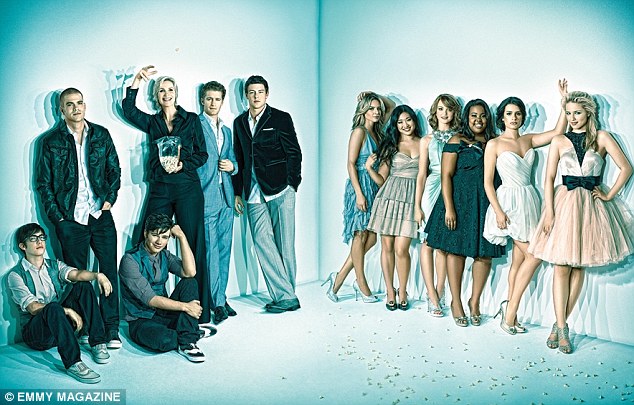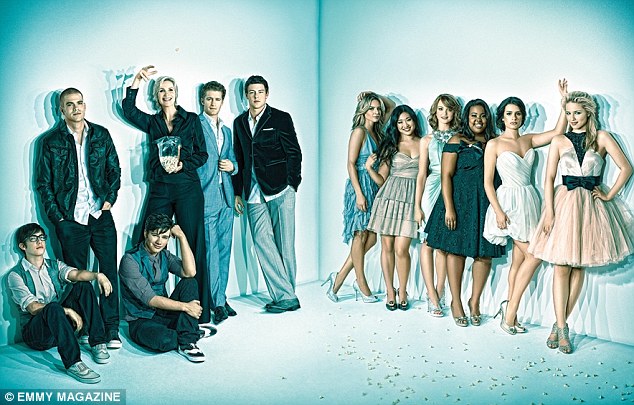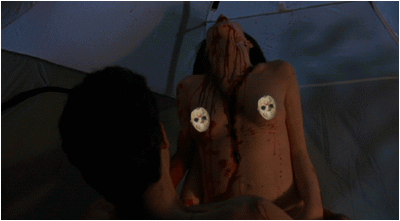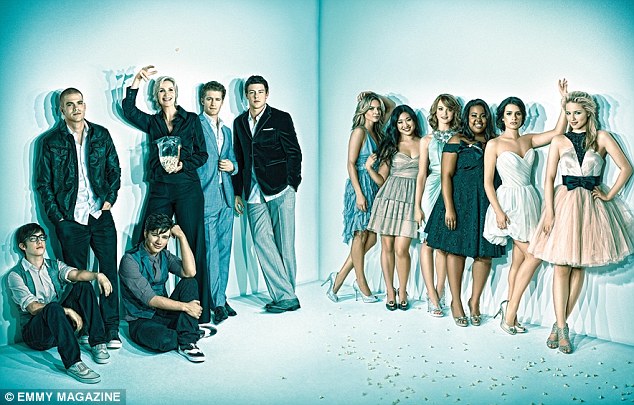Tag: Cali Loria
Women and Gender in Musicals Week: ‘Glee!’
In the beginning Glee made a brand out of celebrating the insecurities, joy, and passions of a group of social outcasts. Quickly, however, Glee called into question its treatment of women, prompting the New York Post to ask “Does Glee! Hate women?” In season one alone a woman is shown to be conniving enough to fake a pregnancy to “keep her man” and another, this time a teenager, grappled with pregnancy until, poof, the storyline magically disappeared. Luckily Madonna’s “Papa Don’t Preach” was able to get into the mix first, or I would have been pissed.
Besides the stereotypical portrayals of women-as-girls-as-GQ-cover-models-being-schoolgirls that this show offers, Glee goes further by, perhaps unintentionally, mocking its characters. Vitriolic gym teacher Sue Sylvester (who eerily resembles my elementary school gym teacher) relies on her bitter use of the pretty girls and exploitation of the token special needs child as a means to succeed to her ultimate end. As their most fully fleshed-out character (and perhaps most accomplished actor) Jane Lynch does a great job being angry but does nothing for the stereotype of the angry lesbian gym teacher taunting kids to make herself feel better. Coach Beiset’s introduction furthered this by presenting this gem of a storyline: no man wanted to kiss her so what was a woman to do but become an angry, middle-aged football coach: the better to scream at you, my dears.
Mixed in with the older women who suffer to fall in and keep love and affection, the teens of Glee keep the teenage dreams coming faster than Katy Perry’s hits. Puck, the number one misogynist/baby daddy/Neil Diamond Crooner and the show’s resident sometimes Gothic sometimes snarky, always shown eating or wrestling, Lauren, are just one of many unconventional couples Glee has drummed up. Lauren’s morbid obesity might once have proven to be a means for character slander, as Puck himself proclaimed when he said to then pregnant Quinn “I’m not breaking up with you. I’m just saying please stop super-sizing because I don’t dig on fat chicks.” Now, however, it is the stuff of fetishistic pop preening. First, Puck serenades his new love interest with a rendition of “Fat Bottom Girls” and, shock, she finds it offensive. To make it better he sings the original number “Big Ass Heart” because it is okay for the organ that pumps our blood and, symbolically, falls us in love to have a “big ass” even though a heart has never won a pie eating contest or needed two seats in an airplane. We get it–there’s a size difference here.
Having a character on TV who does not fit into the mold of being a perfect Westernized ideal of beauty would, in someone else’s hands, be refreshing. Glee, however, focuses on the extremes of women, enjoying the overt and campy hyperbolization of its characters which, in essence, detracts from actual storylines and only serves to render the women flat and one-dimensional: Jewish starlet, slut, dumb blonde, conniving cheerleader, sassy black woman, an Asian, and, now, a full-fleshed female. Glee has a recipe with every ingredient, but stirred together it’s one big lump of heterogeneous stereotypes. I’m not saying this couple should not exist; I am simply implying that it may have been beneficial to give her a love interest that does not appear to be ten seconds from dumping pigs blood over her head at prom.
Two other prominent female characters central to Glee’s narrative arc are slutty Santana and dumb blonde Britney. These two rarely have lines, and, when they do, it is solely to enforce these two personas. What they do have, however, is a girl on girl on glee make out session. Of course Glee would need to have two of its beautiful, popular women fall in love and make out, why not? Glee loves Katy Perry and she kissed a girl and, damn it, she liked it. The issue is not girls kissing girls; it is the exploration of lesbianism in a trite and frivolous manner.
The trials and tribulations girls in high school are facing today are by no means easy. From eating disorders to bullying, the very struggle of learning who you are as a woman, inside, out, sexually, emotionally, is a process. Women today are barraged with images of who they should be, how they should act, and whom they should kiss. Glee, in an attempt to make it okay to be whomever you are, has simply created an hour of sing-along to the pain and pleasure of all the versions of themselves that girls see when they look in the mirror. We are all sexy and scared, stupid and skinny, fat and fabulous–but fleshing out these various facets to frivolous plotlines and self-mocking monologues is akin to giving every girl a Barbie with adjective occupations. Women deserve more than this style of characterization.
Women and Gender in Musicals Week: Glee!
In the beginning Glee made a brand out of celebrating the insecurities, joy, and passions of a group of social outcasts. Quickly, however, Glee called into question its treatment of women, prompting the New York Post to ask “Does Glee! Hate women?” In season one alone a woman is shown to be conniving enough to fake a pregnancy to “keep her man” and another, this time a teenager, grappled with pregnancy until, poof, the storyline magically disappeared. Luckily Madonna’s “Papa Don’t Preach” was able to get into the mix first, or I would have been pissed.
Besides the stereotypical portrayals of women-as-girls-as-GQ-cover-models-being-schoolgirls that this show offers, Glee goes further by, perhaps unintentionally, mocking its characters. Vitriolic gym teacher Sue Sylvester (who eerily resembles my elementary school gym teacher) relies on her bitter use of the pretty girls and exploitation of the token special needs child as a means to succeed to her ultimate end. As their most fully fleshed-out character (and perhaps most accomplished actor) Jane Lynch does a great job being angry but does nothing for the stereotype of the angry lesbian gym teacher taunting kids to make herself feel better. Coach Beiset’s introduction furthered this by presenting this gem of a storyline: no man wanted to kiss her so what was a woman to do but become an angry, middle-aged football coach: the better to scream at you, my dears.
Mixed in with the older women who suffer to fall in and keep love and affection, the teens of Glee keep the teenage dreams coming faster than Katy Perry’s hits. Puck, the number one misogynist/baby daddy/Neil Diamond Crooner and the show’s resident sometimes Gothic sometimes snarky, always shown eating or wrestling, Lauren, are just one of many unconventional couples Glee has drummed up. Lauren’s morbid obesity might once have proven to be a means for character slander, as Puck himself proclaimed when he said to then pregnant Quinn “I’m not breaking up with you. I’m just saying please stop super-sizing because I don’t dig on fat chicks.” Now, however, it is the stuff of fetishistic pop preening. First, Puck serenades his new love interest with a rendition of “Fat Bottom Girls” and, shock, she finds it offensive. To make it better he sings the original number “Big Ass Heart” because it is okay for the organ that pumps our blood and, symbolically, falls us in love to have a “big ass” even though a heart has never won a pie eating contest or needed two seats in an airplane. We get it–there’s a size difference here.
Having a character on TV who does not fit into the mold of being a perfect Westernized ideal of beauty would, in someone else’s hands, be refreshing. Glee, however, focuses on the extremes of women, enjoying the overt and campy hyperbolization of its characters which, in essence, detracts from actual storylines and only serves to render the women flat and one-dimensional: Jewish starlet, slut, dumb blonde, conniving cheerleader, sassy black woman, an Asian, and, now, a full-fleshed female. Glee has a recipe with every ingredient, but stirred together it’s one big lump of heterogeneous stereotypes. I’m not saying this couple should not exist; I am simply implying that it may have been beneficial to give her a love interest that does not appear to be ten seconds from dumping pigs blood over her head at prom.
Two other prominent female characters central to Glee’s narrative arc are slutty Santana and dumb blonde Britney. These two rarely have lines, and, when they do, it is solely to enforce these two personas. What they do have, however, is a girl on girl on glee make out session. Of course Glee would need to have two of its beautiful, popular women fall in love and make out, why not? Glee loves Katy Perry and she kissed a girl and, damn it, she liked it. The issue is not girls kissing girls; it is the exploration of lesbianism in a trite and frivolous manner.
The trials and tribulations girls in high school are facing today are by no means easy. From eating disorders to bullying, the very struggle of learning who you are as a woman, inside, out, sexually, emotionally, is a process. Women today are barraged with images of who they should be, how they should act, and whom they should kiss. Glee, in an attempt to make it okay to be whomever you are, has simply created an hour of sing-along to the pain and pleasure of all the versions of themselves that girls see when they look in the mirror. We are all sexy and scared, stupid and skinny, fat and fabulous–but fleshing out these various facets to frivolous plotlines and self-mocking monologues is akin to giving every girl a Barbie with adjective occupations. Women deserve more than this style of characterization.
Horror Week 2011: The Sexiness of Slaughter: The Sexualization of Women in Slasher Films
Over the course of the series’ eight one-hour episodes, those skilled and sexy enough to command the screen survive. Those who don’t will “get the axe” until only one strong, seductive and stellar actress remains, earning the break-out role in “Saw VI” and the title of Scream Queen.
The season 1 winner, Tanedra Howard, won the chance to show audiences just how seductive and stellar she could look while being tortured.
As years passed, young audiences required that gruesome images become more intense and explicit for them to become scared…In 1978, a movie called Halloween not only sold more tickets than any other horror film, it broke all previous box-office records for any type of film made by an independent production company. Hollywood immediately tried to tap into the success of Halloween. Films such as Friday the 13th, Don’t Go In the House, Prom Night, Terror Train, He Knows You’re Alone, and Don’t Answer the Phone were all released in 1980. These movies, which are some of the first slasher films, were extremely successful. However, with their increasing popularity came strong criticism. Slasher films were condemned for frequently portraying vicious attacks against mostly females and for mixing sex scenes with violent acts.
This popular kill from Jason X involves scientist Andrea getting her face dunked in liquid nitrogen. While struggling with Jason, Andrea’s shit (half of what could be a sexy scientist Halloween costume) rides up revealing to the audience the bottom of her full breasts. While this small glimpse does not equate itself to the arousal of an all-out sex scene, it is intentional. From costuming to blocking, every aspect of the character’s femininity in this scene was meticulously plotted. The fact that filmmakers, audiences, and Maxim find a kill scene more enticing if the woman is sexy and almost shirtless speaks to the fact that modern horror films sexualize slaughter.
Social scientists have expressed concern over the negative effects that slasher films may have on audiences. In particular, exposure to scenes that mix sex and violence is believed to dull males’ emotional reactions to filmed violence, and males are less disturbed by images of extreme violence aimed at women (Linz, Donnerstein & Adams, 1989). These effects on male viewers are said to derive from “classical conditioning”.
Sapolsky and Molitor rebuff this idea, believing that the pairing of sex and violence does not occur often enough for classical condition to occur. However, they further state:
The concern over potential negative effects of exposure to slasher films remains. Possibly, depictions of violence directed at women as well as the substantial amount of screen time in which women are shown in terror may reduce male viewers’ anxiety. Lowered anxiety reduces males’ responses to subsequently-viewed violence, including violence directed at women. Accordingly, the desensitizing effects of slasher films may result from a form of “extinction” and not from classical conditioning.”
It appears that no matter how you slice it, this pairing, on unconscious level, does not leave viewers unaffected.
Emmy Week 2011: Glee!
In the beginning Glee made a brand out of celebrating the insecurities, joy, and passions of a group of social outcasts. Quickly, however, Glee called into question its treatment of women, prompting the New York Post to ask “Does Glee! Hate women?” In season one alone a woman is shown to be conniving enough to fake a pregnancy to “keep her man” and another, this time a teenager, grappled with pregnancy until, poof, the storyline magically disappeared. Luckily Madonna’s “Papa Don’t Preach” was able to get into the mix first, or I would have been pissed.
Besides the stereotypical portrayals of women-as-girls-as-GQ-cover-models-being-schoolgirls that this show offers, Glee goes further by, perhaps unintentionally, mocking its characters. Vitriolic gym teacher Sue Sylvester (who eerily resembles my elementary school gym teacher) relies on her bitter use of the pretty girls and exploitation of the token special needs child as a means to succeed to her ultimate end. As their most fully fleshed-out character (and perhaps most accomplished actor) Jane Lynch does a great job being angry but does nothing for the stereotype of the angry lesbian gym teacher taunting kids to make herself feel better. Coach Beiset’s introduction furthered this by presenting this gem of a storyline: no man wanted to kiss her so what was a woman to do but become an angry, middle-aged football coach: the better to scream at you, my dears.
Mixed in with the older women who suffer to fall in and keep love and affection, the teens of Glee keep the teenage dreams coming faster than Katy Perry’s hits. Puck, the number one misogynist/baby daddy/Neil Diamond Crooner and the show’s resident sometimes Gothic sometimes snarky, always shown eating or wrestling, Lauren, are just one of many unconventional couples Glee has drummed up. Lauren’s morbid obesity might once have proven to be a means for character slander, as Puck himself proclaimed when he said to then pregnant Quinn “I’m not breaking up with you. I’m just saying please stop super-sizing because I don’t dig on fat chicks.” Now, however, it is the stuff of fetishistic pop preening. First, Puck serenades his new love interest with a rendition of “Fat Bottom Girls” and, shock, she finds it offensive. To make it better he sings the original number “Big Ass Heart” because it is okay for the organ that pumps our blood and, symbolically, falls us in love to have a “big ass” even though a heart has never won a pie eating contest or needed two seats in an airplane. We get it–there’s a size difference here.
Having a character on TV who does not fit into the mold of being a perfect Westernized ideal of beauty would, in someone else’s hands, be refreshing. Glee, however, focuses on the extremes of women, enjoying the overt and campy hyperbolization of its characters which, in essence, detracts from actual storylines and only serves to render the women flat and one-dimensional: Jewish starlet, slut, dumb blonde, conniving cheerleader, sassy black woman, an Asian, and, now, a full-fleshed female. Glee has a recipe with every ingredient, but stirred together it’s one big lump of heterogeneous stereotypes. I’m not saying this couple should not exist; I am simply implying that it may have been beneficial to give her a love interest that does not appear to be ten seconds from dumping pigs blood over her head at prom.
Two other prominent female characters central to Glee’s narrative arc are slutty Santana and dumb blonde Britney. These two rarely have lines, and, when they do, it is solely to enforce these two personas. What they do have, however, is a girl on girl on glee make out session. Of course Glee would need to have two of its beautiful, popular women fall in love and make out, why not? Glee loves Katy Perry and she kissed a girl and, damn it, she liked it. The issue is not girls kissing girls; it is the exploration of lesbianism in a trite and frivolous manner.
The trials and tribulations girls in high school are facing today are by no means easy. From eating disorders to bullying, the very struggle of learning who you are as a woman, inside, out, sexually, emotionally, is a process. Women today are barraged with images of who they should be, how they should act, and whom they should kiss. Glee, in an attempt to make it okay to be whomever you are, has simply created an hour of sing-along to the pain and pleasure of all the versions of themselves that girls see when they look in the mirror. We are all sexy and scared, stupid and skinny, fat and fabulous–but fleshing out these various facets to frivolous plotlines and self-mocking monologues is akin to giving every girl a Barbie with adjective occupations. Women deserve more than this style of characterization.
Cali Loria is a thug with unbelievable scrabble skills. She is mother to a King and a lover of film, food, and feminism.





